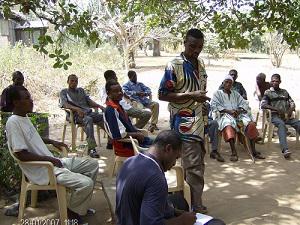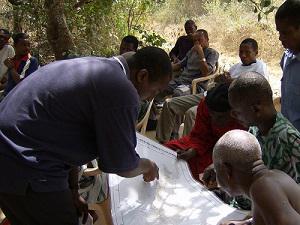Edem Kodzo Ekpe
Other projects
27 Aug 2009
Using Local Strategies for Addressing Crop-Raiding by Wildlife in the Afadjato-Agumatsa Conservation Area
20 Dec 2011
Conserving the Straw-Coloured Fruit Bat, Eidolon helvum (Megachiroptera: Pteropodidae) and its Habitats through Networking of Conservation Volunteers in Ghana
This project will attempt to mitigate crop-destruction by wildlife in farms near the Afadjato-Agumatsa Community Nature Reserve. It is hoped that this will increase local participation in nature conservation and help prevent farmer-forest manager conflicts in the area.

Edem taking notes while a farmer raises his concerns.
The Gbledi and Fodome-Ahor communities in the Hohoe District of the Volta Region of Ghana, in partnership with the Ghana Wildlife Society have been implementing the Afadjato-Agumatsa Community Forest Conservation Project since December 1998 with the aim of conserving biodiversity and the aesthetics on Mount Afadjato and the adjoining Agumatsa range.

Edem discussing a map with some farmers.
Afadjato is the highest mountain in Ghana at 885m above sea level. The site is one of the globally Important Bird Areas in Ghana and forms part of the ranges constituting the remaining afro-montane and Upper Guinea forests, a biodiversity hotspot. A key achievement of the project was the establishment and management of a community nature reserve with active support and participation of the local people.
However, wild animals from the reserve raid farms and destroy crops drawing complaints from local farmers. Since farming is the major occupation, this adversely affects livelihoods of the communities, can reduce local participation in conservation and has the potential of resulting in farmer-forest manager conflicts. My project therefore proposes to use participatory processes to assess crop-destruction by wildlife in farms near the Community Nature Reserve. Also, the influencing factors will be assessed and evaluated.
Drawing on local knowledge and participation, appropriate local mitigating strategies will be developed. The project activities would help develop local capacity for natural resource management and improve public awareness on the issue of farm-raiding by wildlife. Ultimately, it is expected that these activities would result in the development of local traditional knowledge for natural resource management, increasing local participation in nature conservation and preventing farmer-forest manager conflicts in the area.